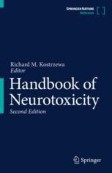Search
Search Results
-
Dose-Ranging Effects of the Intracerebral Administration of Atsttrin in Experimental Model of Parkinson’s Disease Induced by 1-Methyl-4-phenyl-1,2,3,6-tetrahydropyridine (MPTP) in Mice
Parkinson’s disease is one of the most common neurodegenerative disorders characterized by a multitude of motor and non-motor clinical symptoms...

-
Glimepiride Prevents 1-Methyl-4-Phenyl-1,2,3,6-Tetrahydropyridine Induced Dopamine Neurons Degeneration Through Attenuation of Glia Activation and Oxidative Stress in Mice
It is well established that there is a link between type 2 diabetes mellitus and Parkinson’s disease (PD) evidenced in faster progression and more...

-
Pyruvate Prevents Dopaminergic Neurodegeneration and Motor Deficits in the 1-Methyl-4-Phenyl-1,2,3,6-Tetrahydropyridine Model of Parkinson’s Disease
Parkinson’s disease (PD) is a progressive neurodegenerative disorder characterized by the selective loss of dopamine(DA)rgic neurons in the...

-
Intestinal Dopamine Receptor D2 is Required for Neuroprotection Against 1-Methyl-4-phenyl-1,2,3,6-tetrahydropyridine-induced Dopaminergic Neurodegeneration
A wealth of evidence has suggested that gastrointestinal dysfunction is associated with the onset and progression of Parkinson’s disease (PD)....

-
Neuroprotective Activities of Long-Acting Granulocyte–Macrophage Colony-Stimulating Factor (mPDM608) in 1-Methyl-4-Phenyl-1,2,3,6-Tetrahydropyridine-Intoxicated Mice
Loss of dopaminergic neurons along the nigrostriatal axis, neuroinflammation, and peripheral immune dysfunction are the pathobiological hallmarks of...

-
Silymarin Protects Against Impaired Autophagy Associated with 1-Methyl-4-phenyl-1,2,3,6-tetrahydropyridine-Induced Parkinsonism
1-Methyl-4-phenyl-1,2,3,6-tetrahydropyridine (MPTP) exacerbates mitochondrial impairment and α-synuclein expression leading to Parkinsonism. Impaired...

-
Chrysin for Neurotrophic and Neurotransmitter Balance in Parkinson’s Disease
1-Methyl-4-phenyl-1,2,3,6-tetrahydropyridine (MPTP) has a direct impact on the dopaminergic neurons in the substantia nigra pars compacta (SNpc),...
-
Assay of MAO Inhibition by Chromatographic Techniques (HPLC/HPLC-MS)
Monoamine oxidase (MAO) enzymes (MAO A and B) catalyze the oxidative deamination of biogenic amines, neurotransmitters, and xenobiotic amines and...
-
MPTP: Advances from an Evergreen Neurotoxin
Since its discovery in 1976, 1-methyl-4-phenyl-1,2,3,6-tetrahydropyridine (MPTP) models in rodents and nonhuman primates have continuously renewed to...
-
Involvement of Abnormal p-α-syn Accumulation and TLR2-Mediated Inflammation of Schwann Cells in Enteric Autonomic Nerve Dysfunction of Parkinson’s Disease: an Animal Model Study
The study was designed to investigate the pathogenesis of gastrointestinal (GI) impairment in Parkinson’s disease (PD). We utilized...

-
MPTP: Advances from an Evergreen Neurotoxin
Since its discovery in 1976, 1-methyl-4-phenyl-1,2,3,6-tetrahydropyridine (MPTP) models in rodents and nonhuman primates have continuously renewed to...
-
Whether the Subacute MPTP-Treated Mouse is as Suitable as a Classic Model of Parkinsonism
1-methyl-4-phenyl-1,2,3,6-tetrahydropyridine (MPTP) mice model is one of the most common animal models for Parkinson’s disease (PD). It is classified...

-
Purple pitanga extract (Eugenia uniflora) attenuates oxidative stress induced by MPTP
1-Methyl-4-phenyl-1,2,3,6-tetrahydropyridine (MPTP) has been widely used due to its specific and reproducible neurotoxic effect on the nigrostriatal...

-
Neurotoxicity: Calpain and 1-Methyl-4-phenylpyridinium (MPP+)
MPTP (1-methyl-4-phenyl-1,2,3,6-tetrahydropyridine) is commonly utilized in animal models of Parkinson’s disease. This compound is metabolized in the...
-
GUCY2C signaling limits dopaminergic neuron vulnerability to toxic insults
Mitochondrial dysfunction and reactive oxygen species (ROS) accumulation within the substantia nigra pars compacta (SNpc) are central drivers of...

-
Generation of Mitochondrial Toxin Rodent Models of Parkinson’s Disease Using 6-OHDA , MPTP , and Rotenone
Several animal models are employed to discover novel treatments for the symptoms of Parkinson’s disease (PD). PD models can be divided into two...
-
Mitochondria-Targeted Liposomal Delivery in Parkinson’s Disease
Mitochondrial dysfunction in Parkinson’s Disease (PD) is implicated through both environmental exposure and genetic factors (Grünewald et al. 2016;...
-
Amelioration of Astrocyte-Mediated Neuroinflammation by EI-16004 Confers Neuroprotection in an MPTP-induced Parkinson’s Disease Model
Parkinson’s disease (PD) is a neurodegenerative disorder that results in motor impairment due to dopaminergic neuronal loss. The pathology of PD is...

-
Survey of Selective Monoaminergic Neurotoxins Targeting Dopaminergic, Noradrenergic, and Serotoninergic Neurons
The concept of selective neurotoxicity was highlighted in the 1930s by the noted Physiologist Walter Canon who promoted the concept of “absence...
-
Survey of Selective Monoaminergic Neurotoxins Targeting Dopaminergic, Noradrenergic, and Serotoninergic Neurons
The concept of selective neurotoxicity was highlighted in the 1930s by the noted Physiologist Walter Canon who promoted the concept of “absence...
